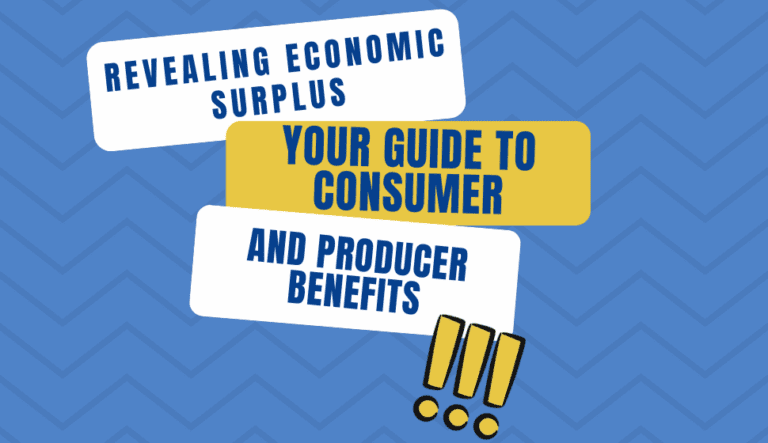A key idea in microeconomics, economic surplus offers important insights into resource allocation and market outcomes. Producer excess and consumer surplus are two essential elements of economic surplus. We will examine the importance of economic surplus, delve into the complexities of producer and consumer surplus, and comprehend how these ideas are crucial to the field of microeconomics in this extensive book.
Understanding Economic Surplus
1. The Essence of Economic Surplus
Economic surplus is fundamentally the net profit from market exchanges. It puts a number on the value that buyers obtain and the earnings that sellers make during trade. This idea is based on comparing the price that customers are prepared to pay for a good or service to the cost that producers must pay to provide it. This gap, expressed as producer and consumer surplus, captures the fundamentals of economic efficiency as well as the dynamics of resource allocation and market interactions. Gaining an understanding of the fundamental principles that influence market outcomes and microeconomic decision-making requires an understanding of the essence of economic surplus.
2. Consumer Surplus: The Buyer’s Delight
Shoppers and purchasers smile when they hear the concept of consumer excess. It stands for the added value that customers obtain when they buy a product for less than they are willing to pay in total. The area between the demand curve and the actual price that customers pay is how this excess is visually represented. It’s evidence of how happy customers are when they get a good bargain, and it’s important for setting prices, ensuring the welfare of customers, and maintaining market efficiency. A high degree of surplus among consumers indicates that they are adding value and feeling satisfied when they make purchases.
3. Producer Surplus: A Reward for Suppliers
The money that suppliers get in exchange for their goods or services is known as producer surplus. It stands for the discrepancy between the going rate and the lowest price manufacturers are prepared to take for their products or services. This excess motivates producers to use resources wisely and is a key factor in profit maximization. It provides a material incentive for assuming the risks and financial outlays related to production and entrepreneurship. A sufficient amount of producer surplus stimulates investment and innovation, enhancing the life and energy of markets.
The Significance of Consumer Surplus

1. Price Determination and Consumer Surplus
- Consumer surplus is a crucial factor in price determination. When the market price is lower than what consumers are willing to pay, it creates a consumer surplus.
- This surplus reflects the added value consumers receive, encouraging them to continue purchasing goods or services.
2. Consumer Welfare and Market Efficiency
- A high level of consumer surplus indicates greater consumer welfare and satisfaction. It signifies that consumers are obtaining goods and services at prices lower than their perceived value.
- In a competitive market, consumer surplus contributes to market efficiency by ensuring resources are allocated to their highest-valued uses.
The Impact of Producer Surplus

1. Profit Maximization for Producers
- Producer surplus is a vital component of profit maximization. When producers can sell goods at prices higher than their minimum acceptable level, it results in producer surplus.
- This surplus represents the additional earnings that incentivize producers to allocate resources efficiently.
2. Incentives for Innovation and Investment
- High levels of producer surplus provide incentives for businesses to invest in research, innovation, and the development of new products and services.
- It rewards producers for taking on the risks associated with production and entrepreneurship.
Market Outcomes and Economic Efficiency
- An optimal market outcome, often referred to as a Pareto-efficient allocation, occurs when there is neither consumer nor producer surplus left on the table.
- This indicates that resources are distributed in a way that maximizes total economic surplus and promotes economic efficiency.
Real-World Application of Economic Surplus
- Economic surplus is not just a theoretical concept but has real-world implications for various industries and policy decisions.
- It informs governments and policymakers about the efficiency of markets, which can guide regulatory actions and interventions.
Conclusion: Unlocking the World of Microeconomics with Economic Surplus
- Consumer surplus and producer surplus are the cornerstones of economic surplus, providing valuable insights into market dynamics.
- Consumer surplus represents the benefit enjoyed by consumers when they pay less than their maximum willingness to pay, while producer surplus reflects the additional earnings that reward producers.
- Understanding economic surplus is not only essential for microeconomics students but also for businesses and policymakers seeking to make informed decisions.
If you’re a student looking to excel in microeconomics or need assistance with assignments, consider exploring the nuances of economic surplus. For comprehensive support, Assignment Unlocked offers top-notch microeconomics homework help. Contact us today and unlock your potential in the field of microeconomics.






